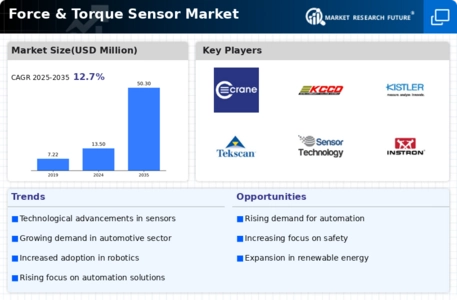By Region, the study provides market insights into North America, Europe, Asia-Pacific, Middle East & Africa, and South America. Asia-Pacific is anticipated to dominate the Force & Torque Sensor market in 2023 and exhibit the highest CAGR during the forecast period.
Among Region, North America holds the highest market share of 38.4% in 2023 in Force & Torque Sensor market, the market for North America was valued at USD 4,470.3 Million in 2023 and is anticipated to reach USD 13,327.7 Million in 2032 growing at a CAGR of 12.5%.
North America, consisting of the US, Canada, and Mexico, stands at the forefront of technological innovation in Force & Torque Sensor market. The North America Force & Torque Market is growing rapidly, and the growth of the region is attributed to the growing adoption of automation across industries.
As evident from the recent report released by Robotic Federation, the total deployment of robots in US have increased and it forms around 10% of the total robots deployed in 2023.Accroding to robotic federation, In the Americas, installations of the industrial robots were up 8% to 56,053 units in 2022, surpassing the 2018 peak level (55,212 units). The United States, the largest regional market, accounted for 71% of the installations in the Americas in 2022. Robot installations were up by 10% to 39,576 units. The main growth driver was the automotive industry that displayed surging installations by +47% (14,472 units).
The share of the automotive industry has now grown back to 37%, followed by the metal and machinery industry (3,900 units) and the electrical/electronics industry (3,732 units). The two other major markets are Mexico – here installations grew by 13% and Canada, where demand dropped by 24% (3,223 units). This was the result of lower demand from the automotive industry - the strongest adopter. Theses surging deployment of Robots create high demand for the Force & Torque sensors in the market which are important to gain precision by the robots to efficiently perform its tasks.
The European Force & Torque Sensor has been showing remarkable growth in the demand of the Force & Torque sensors. The growth of the market is attributed to the growing demand from the existing automotive industry in the region. Europe is home to some of the major automotive market players. For instance, Bayerische Motoren Werke AG, Mercedes-Benz Group AG, and Volkswagen AG are Headquartered in Germany, Stellantis NV headquartered in Netherlands, Renault SA is headquartered in France. These market players drive huge demand for Force & Torque sensors in the region.
The Force & Torque sensor market in the Middle East and Africa (MEA) region is growing rapidly due to advancements in technology and the increasing reliance on precise Force & Torque measurement in various industries. Force & Torque sensors are used in applications such as automotive, medical device, aerospace, manufacturing to quantify the amount of force exerted on a component, or assembly. The automotive vertical is predicted to play an important role in the growth of the torque sensor market in this region due to large-scale manufacturing and major investments in new vehicle technologies.
The growing demand for energy and large-scale manufacture of various sorts of items for export are facilitating the Force & Torque sensor industry. Collaboration between governments, private sector companies, and research institutions is crucial in advancing the Force & Torque sensor market in the MEA region, fostering innovation, supporting local manufacturing, and ensuring the latest sensor technologies are readily available for various applications.
FIGURE3: FORCE & TORQUE SENSOR MARKET SIZE BY REGION 2023 & 2032



















Leave a Comment